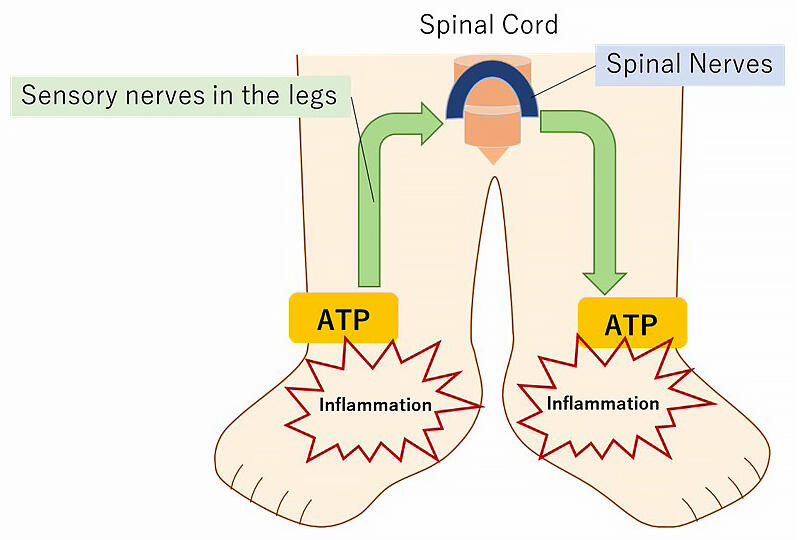A research group consisting of Professor Masaaki Murakami of the Institute for Genetic Medicine, Hokkaido University, members of the Institute for Quantum Life Science, National Institutes for Quantum Science and Technology, and members of the National Institute for Physiological Sciences, the National Institutes of Natural Sciences has succeeded in clarifying the molecular mechanism that causes local inflammation to spread symmetrically between lesions in remote positions in inflammatory diseases using multiple rheumatoid arthritis models. They have defined this as the remote inflammation gateway reflex.

Provided by Hokkaido University with modifications
One of the diagnostic standards for rheumatoid arthritis is symmetrical inflammatory lesions in remote positions. Similar inflammatory lesions form due to inflammatory diseases such as interstitial pneumonia and psoriasis. It has been suggested that these remote inflammations are connected to the nervous system, but the truth of this was unclear.
Since first identifying the gravity-mediated gateway reflex in 2012, the research group has discovered five gateway reflexes. This time, the group carried out tests using a rheumatoid arthritis mouse model, based on the idea that a new gateway reflex contributes to the formation of remote inflammation, and discovered the remote inflammation gateway reflex, a new molecular mechanism.
In the remote inflammation gateway reflex, ATP is generated by inflammation in the leg muscles on one side of a rheumatoid arthritis mouse model. This stimulates, in order, the sensory nerves and then the proenkephalin-positive interneurons in the spine. After this, the sensory nerves supplying the leg muscles on the other side are stimulated. As a result, ATP is released in retrograde fashion from the stimulated sensory nerves, introducing inflammation due to the activation of IL-6 AMP in the vascular endothelial cells and fibroblasts on the other side. With this, the group learned that ATP acts as a neurotransmitter and inflammation exacerbation factor in the remote inflammation gateway reflex.
It is hoped that, based on these results, the neural circuit of the remote inflammation gateway reflex and ATP will become targets for therapy for inflammatory diseases that cause remote inflammation, such as rheumatoid arthritis-associated interstitial pneumonia and psoriasis.
Professor Murakami commented, "This study was part of the 'Quantum and neuromodulation technologies to suppress tissue-specific disease-related microinflammations' Moonshot research project of the Japan Agency for Medical Research and Development (AMED), and one of its objectives was the spread of medical treatment through neuro-modulation. There is a possibility that the neural circuit can be turned on and off using artificial stimuli. Thus, we hope to develop applications toward our goal based on this discovery."
■ The remote inflammation gateway reflex: A phenomenon that involves the formation of an opening (a blood vessel gate) in the blood vessels of the central nervous system (brain, spine) that allows immune cells in the blood to penetrate these vessels, which they cannot normally do. This is caused by the activation of a specific neural circuit due to particular environmental or artificial stimulation, which leads to the release of noradrenalin, a neurotransmitter, in particular parts of these blood vessels. This phenomenon was first discovered by Professor Murakami's research group in 2012.
This article has been translated by JST with permission from The Science News Ltd.(https://sci-news.co.jp/). Unauthorized reproduction of the article and photographs is prohibited.




